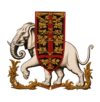Bule
| Bule Republic Folkeveldet Bule | |
| Flag | Coat of arms |
|---|---|

|

|
| Motto: "Å bevare den gyldne horisonten av velstand" - "Preserving the golden horizon of prosperity" | |
| Anthem: Kor av nybyggere - Chorus of the settlers | |
| Locator map | |

| |
| Capital city | Solbergstad |
| Largest city | New Anaria |
| Official language | Aedelish |
| Other languages | Aedelish Patois and Native languages |
| Ethnic group | Aldsay - Awawatu |
| Religion | Orkanan - Naskel |
| Demonym(s) | Bubale, Adalu |
| Government | |
| Government Type | Unitary Republic |
| President | Lars Bergstrøm |
| Prime Minister | Henrik Nordahl |
| Legislature | Senate of Bule |
| Establishment | |
| Declaration of Independence | tbc |
| Area | |
| Total | 5,004,823.07 km2 km2 |
| Population | |
| Total | 74,159,966.77 |
| Density | 14.82/km2 |
| Economy | |
| Economy type | Capitalist |
| GDP (total) | Ꞡ 381,330,549,154 |
| GDP per capita | Ꞡ 5,142 |
| Currency | Bule Skilling (skilling-bule.png) |
| Inequality index | 25.5 |
| Development index | 0.875 |
| Other information | |
| Time zone | tbc |
| Driving side | right |
| Calling code | tbc |
| Internet code | .bl |
Bule, officially the Bule Republic (Aedelish: Folkeveldet Bule), is a country.
History
Simal Island Traders Influence (Antiquity - 7230)
In antiquity, the coastal and delta regions of Bule were intimately entwined with the Simal Island Traders, a seafaring civilization renowned for their mastery of the waves. These coastal areas became vital crossroads of commerce and culture, primarily due to their extensive interactions with the Simal traders. The rest of the Bule region, however, was quite different, dominated by small pastoral chiefdoms and petty kingdoms.
The Simal traders established thriving coastal settlements along the Bule coast, fostering vibrant exchanges of goods and knowledge with the indigenous peoples of Tzeraka. This coastal interaction allowed for the introduction of exotic goods and beasts, transported from the heart of Bule, to the bustling trade hubs where Simal and Bule cultures converged.
The impact of the Simal Island Traders on Bule's coastal architecture, art, and societal norms was profound, leaving an indelible imprint on the local way of life. The coastal regions flourished as bustling hubs of trade, while the interior retained its distinct character, marked by a patchwork of small pastoral chiefdoms and petty kingdoms, largely untouched by the Simal influence.
The Simal Interregnum Civil War, however, disrupted this once-thriving coastal trade and severed the cultural ties between the coastal and interior regions, ultimately leading to the decline of the Simal influence in Bule.